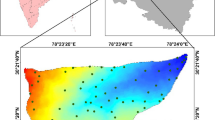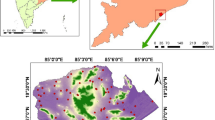Abstract
Delineation of management zones (MZs) are needed to manage fields in order to maximize economic return, minimize environmental impact, and improve soil and crop management. The MZs of uniform production potential may offer an effective solution to nutrient management. In this study, a total of 122 geo-referenced representative surface (0–250 mm depth) soil samples were collected from the study area covering an area of 6296 ha. Soil samples were analysed for pH, EC, CaCO3, organic carbon (SOC), available nitrogen (AN), available phosphorus (AP), available potassium (AK) and micronutrients (Fe, Mn, Zn and Cu). Their spatial variability was analyzed and spatial distribution maps were constructed using geostatistical techniques. Geostatistical analysis showed that exponential, rational quadratic, tetraspherical, pentaspherical and circular models were the best-fit models for soil properties and available nutrients. Further, geographical weighted principal component analysis (GWPCA) and possibilistic fuzzy C-means (PFCM) clustering algorithm were carried out to delineate the management zones based on optimum clusters identified using fuzzy performance index (FPI) and normalized classification entropy (NCE). The results revealed that the optimum number of MZs for this study area was four and there was heterogeneity in soil nutrients in four MZs. The study indicated that MZ-based soil test crop response recommendation reduces the application quantity of fertilizer significantly at a large extent. Therefore, the management zone concept can reduce agricultural inputs and environmental pollution, and maximize crop production.







Similar content being viewed by others
References
Anderberg, M. R. (1973). Cluster analysis for applications. New York, USA: Academic Press Inc.
Bezdek, J. C. (1981). Pattern recognition with fuzzy objective function algorithms. New York, USA: Plenum.
Bullock, D. S., Kitchen, N., & Bullock, D. G. (2007). Multidisciplinary teams: A necessity for research in precision agriculture systems. Crop Science,47, 1765–1769.
Burrough, P. A. (1989). Fuzzy mathematical methods for soil survey and land evaluation. Journal of Soil Science,40, 477–492.
Cambardella, C. A., Moorman, T. B., Novak, J. M., Parkin, T. B., Karlen, D. L., Turco, R. F., et al. (1994). Field-scale variability of soil properties in central Iowa soils. Soil Science Society of America Journal,58, 1501–1511.
Cebeci, Z., Yildiz, F., Kavlak, A. T., Cebeci, C., & Onder, H. (2018). ppclust: Probabilistic and Possibilistic Cluster Analysis. R package version 0.1.1, URL https://CRAN.R-project.org/package=ppclust. Accessed 22 August 2018.
Chatterjee, S., Santra, P., Majumdar, K., Ghosh, D., Das, I., & Sanyal, S. K. (2015). Geostatistical approach for management of soil nutrients with special emphasis on different forms of potassium considering their spatial variation in intensive crop** system of West Bengal. India. Environmental Monitoring and Assessment,187, 183. https://doi.org/10.1007/s10661-015-4414-9.
Davatgar, N., Neishabouri, M. R., & Sepaskhah, A. R. (2012). Delineation of site specific nutrient management zones for a paddy cultivated area based on soil fertility using fuzzy clustering. Geoderma,173–174, 111–118. https://doi.org/10.1016/j.geoderma.2011.12.005.
Flowers, M., Weisz, R., & White, J. G. (2005). Yeild-based management zones and grid sampling strategies: Describing soil test and nutrient availability. Agronomy Journal,97(3), 968–982.
Fotheringham, A. S., Brunsdon, C., & Charlton, M. (2002). Geographically weighted regression: The analysis of spatially varying relationships. Chichester, UK: Wiley.
Fridgen, J. J., Kitchen, N. R., Sudduth, K. A., Drummond, S. T., Wiebold, W. J., & Fraisse, C. W. (2004). Mnagement zone analyst (MZA): Software for subfield management zone delineation. Agronomy Journal,96, 100–108.
Gollini, I., Lu, B., Charlton, M., Brunsdon, C., & Harris, P. (2015). GWmodel: An R package for exploring spatial heterogeneity using geographically weighted models. Journal of Statistical Software,63, 1–50.
Goovaerts, P. (1998). Geostatistical tools for characterizing the spatial variability of microbiological and physico-chemical soil properties. Biology and Fertility of Soils,27, 315–334.
Guastaferro, F., Castrignanò, A., Benedetto, D., Sollitto, D., Troccoli, A., & Cafarelli, B. (2010). A comparison of different algorithms for the delineation of management zones. Precision Agriculture,11, 600–620.
Hanway, J. J., & Heidel, H. (1952). Soil analysis methods as used in Iowa State College Soil Testing Laboratory. Iowa Agriculture,57, 1–31.
Harris, P., Brunsdon, C., & Charlton, M. (2011). Geographically weighted principal components analysis. International Journal of Geographical Information Science,25, 1717–1736.
Harris, P., Brunsdon, C., Charlton, M., Juggins, S., & Clarke, A. (2014). Multivariate spatial outlier detection using robust geographically weighted methods. Mathematical Geosciences,46, 1–31.
Hornung, A., Khosla, R., Reich, R., Inman, D., & Westfall, D. G. (2006). Comparsion of site specific management zones: Soil-color-based and yield-based. Agronomy Journal,98(2), 407–415.
Jackson, M. L. (1973). Soil chemical analysis. New Delhi: Prentice Hall of India Pvt. Ltd.
Jena, R. K., Duraisami, V. P., Sivasamy, R., Shanmugasundaram, R., Krishnan, R., Padua, S., et al. (2015). Spatial variability of soil fertility parameters in Jirang Block of Ri-Bhoi District, Meghalaya. Clay Research,34(1), 35–45.
Jenny, H., & Raychaudhuri, S. P. (1960). Effect of climate and cultivation on nitrogen and organic matter reserves in Indian Soils. New Delhi, India: ICAR.
Krige, D. G. (1981). Lognormal-de Wijsian geostatistics for ore evaluation. Johannesburg, South Africa: Printpak (Cape) Ltd.
Krishnapuram, R., & Keller, J. M. (1993). A possibilistic approach to clustering. IEEE Transactions on Fuzzy Systems,1(2), 98–110.
Lindsay, W. L., & Norvell, W. A. (1978). Development of a DTPA soil test for zinc, iron, manganese, and copper. Soil Science Society of America Journal,42, 421–428.
Liu, D. W., Wang, Z. M., Zhang, B., Song, K. S., Li, X. Y., et al. (2006). Spatial distribution of soil organic carbon and analysis of related factors in croplands of the black soil region, Northeast China. Agriculture, Ecosystem and Environment,113, 73–81.
Mc Bratney, A. B., & Moore, A. W. (1985). Application of fuzzy sets to climatic classification. Agricultural and Forest Meteorology,35, 165–185.
Moharana, P. C., Naitam, R. K., Verma, T. P., Meena, R. L., Kumar, Sunil, Tailor, B. L., et al. (2017). Effect of long-term crop** systems on soil organic carbon pools and soil quality in western plain of hot arid India. Archives of Agronomy and Soil Science,63, 1661–1675.
Olsen, S. R., Cole, C. V., Watanabe, F. S., & Dean, L. A. (1954). Estimation of available phosphorus in soils by extraction with sodium bicarbonate. USDA Circular No. 939.
Ortega, R. A., & Santibanez, O. A. (2007). Determination of management zones in corn (Zea mays L.) based on soil fertility. Computers and Electronics in Agriculture,58, 49–59.
Page, T., Haygarth, P. M., Beven, K. J., Jones, A., Butler, T., Keeler, C., et al. (2005). The spatial variability of soil phosphorus in relation to topographic indices and important source areas: Samples to assess the risks to water quality. Journal of Environmental Quality,34, 2263–2277.
Pal, N. R., Pal, K., Keller, J. M., & Bezdek, J. C. (2005). A possibilistic fuzzy c-means clustering algorithm. IEEE Transactions on Fuzzy Systems,13(4), 517–530.
Peralta, N. R., & Costa, J. L. (2013). Delineation of management zones with soil apparent electrical conductivity to improve nutrient management. Computers and Electronics in Agriculture,99, 218–226.
R-Core-Team. (2013). R: A language and environment for statistical computing. Vienna, Austria: R Foundation for Statistical Computing.
Reyniers, M., Maertens, K., Vrindts, E., & De Baerdemaeker, J. (2006). Yield variability related to landscape properties of a loamy soil in central Belgium. Soil and Tillage Research,88, 262–273.
Reza, S. K., Nayak, D. C., Mukhopadhyay, S., Chattopadhyay, T., & Singh, S. K. (2017). Characterizing spatial variability of soil properties in alluvial soils of India using geostatistics and geographical information system. Archives of Agronomy and Soil Science,63, 1489–1498.
Richards, L. A. (1954). Diagnosis and improvement of saline and improvement of saline and alkali soils, USDA Agricultural Handbook 60. Washington DC, USA: US Government Printing Office.
Ruffo, M. L., Bollero, G. A., Hoeft, R. G., & Bullock, D. G. (2005). Spatial variability of the Illinois soil nitrogen test: Implications for soil sampling. Agronomy Journal,97(6), 1485–1492.
Schepers, A. R., Shanaham, J. F., Liebig, M. A., Schepers, J. S., Johnson, S. H., & Luchiari, J. A. (2004). Appropriateness of management zones for characterizing spatial variability of soil properties and irrigated corn yields across years. Agronomy Journal,96, 195–203.
Shukla, A. K., Sinha, N. K., Tiwari, P., Prakash, C., Behera, S. K., Lenka, N. K., et al. (2017). Spatial distribution and management zones for sulphur and micronutrients in Shiwalik Himalayan region of India. Land Degradation and Development,28, 959–969.
Singh, S. K., Kumar, M., Sharma, B. K., & Tarfadar, J. C. (2007). Depletion of organic carbon, phosphorus and potassium stock under pearl millet based crop** sequence in arid environment of India. Arid Land Research and Management,21, 119–131.
Soil Survey Staff. (1999). Soil taxonomy: A basic system of soil classification for making and interpreting soil surveys (2nd ed.). USDA-Natural Resources Conservation Service, Agriculture Handbook, 436, Washington, DC, USA.
Srinivasarao, C., Venkateswarlu, B., Lal, R., Singh, A. K., Kundu, S., Vittal, K. P. R., et al. (2014). Long-term manuring and fertilizer effects on depletion of soil organic carbon stocks under pearl millet-cluster bean-castor rotation in western India. Land Degradation and Development,25, 173–183.
Subbiah, B. V., & Asija, G. L. (1956). A rapid method for the estimation of available nitrogen in soils. Current Science,25, 259–260.
Tripathi, R., Nayak, A. K., Shahid, M., Lal, B., Gautam, P., Raja, R., et al. (2015). Delineation of soil management zones for a rice cultivated area in eastern India using fuzzy clustering. CATENA,133, 128–136.
Varmuza, K., & Filzmoser, P. (2009). Introduction to multivariate statistical analysis in chemo-metrics. Boca Raton, FL, USA: CRC Press.
Voltz, M., & Webster, R. (1990). A comparison of kriging, cubic splines and classification for predicting soil properties from sample information. Journal of Soil Science,41, 473–490.
Walkley, A., & Black, I. A. (1934). An examination of the Degtjareff method for determining soil organic matter and a proposed modification of the chromic acid titration method. Soil Science,37, 29–38.
Webster, R., & Oliver, M. A. (2007). Geostatistics for environmental scientists. Chichester, UK: Wiley.
**n-Zhang, W., Guo-Shun, L., Hong-Chao, H., Zhen-Hai, W., Qing-Hua, L., Xu-Feng, L., et al. (2009). Determination of management zones for a tobacco field based on soil fertility. Computer and Electronics in Agriculture,65, 168–175.
Acknowledgements
The study was funded by ICAR-National Bureau of Soil Survey and Land Use Planning (NBSS & LUP), Nagpur, India in the form of institutional project. The authors are thankful to the Director, NBSS & LUP, Nagpur and the Head, NBSS & LUP Regional Centre, Udaipur for providing facilities for successful completion of the research work.
Author information
Authors and Affiliations
Corresponding author
Ethics declarations
Conflict of interest
The authors declare that they have no conflict of interest.
Additional information
Publisher's Note
Springer Nature remains neutral with regard to jurisdictional claims in published maps and institutional affiliations.
Rights and permissions
About this article
Cite this article
Moharana, P.C., Jena, R.K., Pradhan, U.K. et al. Geostatistical and fuzzy clustering approach for delineation of site-specific management zones and yield-limiting factors in irrigated hot arid environment of India. Precision Agric 21, 426–448 (2020). https://doi.org/10.1007/s11119-019-09671-9
Published:
Issue Date:
DOI: https://doi.org/10.1007/s11119-019-09671-9




